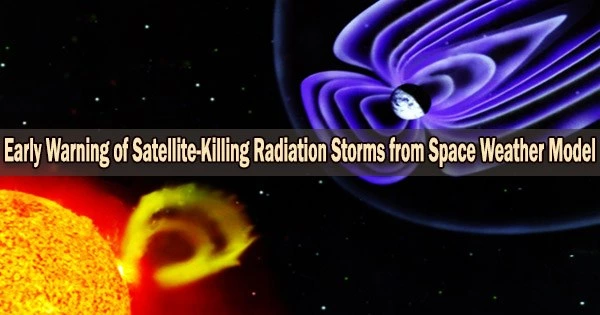Space weather refers to the conditions in Earth’s magnetosphere, ionosphere, and thermosphere due to the constant interaction with the solar wind, which is a stream of charged particles emitted by the sun. Radiation storms are caused by solar flares and coronal mass ejections (CMEs), which can damage or destroy satellites in orbit.
According to a recent publication in the journal Space Weather, a new machine-learning computer model properly forecasts harmful radiation storms brought on by the Van Allen belts two days beforehand, providing the earliest warning to date.
“Radiation storms from the Van Allen belts can damage or even knock out satellites orbiting in medium and high altitudes above the Earth, but predicting these storms has always been a challenge,” said Yue Chen, a space scientist at Los Alamos National Laboratory and principal investigator on the project jointly funded by NASA and NOAA.
“Given that the Van Allen Probes, which provided important data about space weather, recently de-orbited, we no longer have direct measurements about what’s happening in the outer electron radiation belt. Our new model uses existing data sets to ‘learn’ patterns and predict future storms so satellite operators can take protective measures, including temporarily shutting down part of or even the whole satellite to avoid damage.”
By testing the model with multiple machine-learning algorithms, this work confirms the predictability of MeV electrons, as well as the robustness of using low-Earth-orbit electron observations to drive predictions. In addition, the framework set up in this work allows us to easily include more input parameters to predict more energetic electrons in the next step.
Yue Chen
This prediction model extends a previous model that successfully forecast radiation storms one day in advance for megaelectron-volt (MeV) electrons in the outer Van Allen belt of the Earth.
PreMevE 2.0 is a new model that incorporates upstream solar wind speeds to enhance forecasts. It makes predictions by using historical data sets from NOAA and Los Alamos satellites to train and discover significant patterns in electron behavior.
“With the expectation that similar patterns may reveal themselves in the future, our model is capable of making predictions by capturing some critical signatures as a precursor to those future events,” explained Youzuo Lin, a computational scientist at Los Alamos who developed the machine-learning algorithms for the model.
“By testing the model with multiple machine-learning algorithms, this work confirms the predictability of MeV electrons, as well as the robustness of using low-Earth-orbit electron observations to drive predictions,” added Chen. “In addition, the framework set up in this work allows us to easily include more input parameters to predict more energetic electrons in the next step.”
The machine learning framework created for PreMevE 2.0 can also be used for a wide range of general applications that make use of time-related metrics, such as finding patterns in seismic time-series data to enable the detection of tiny earthquakes in noisy environments.





